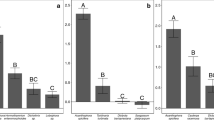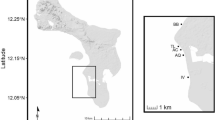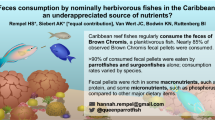Abstract
Marine studies on herbivory have addressed the role of algae as food and shelter for small consumers, but the potential of benthic cyanobacteria to play similar roles is largely unknown. Here, feeding preferences were measured for eight invertebrate consumers from Guam, offered four common macroalgae and two cyanobacteria. The survivorship of another consumer raised on either macroalgae or cyanobacteria was also assessed. From the choices offered, the sacoglossans Elysia rufescens and E. ornata consumed the green macroalga Bryopsis pennata. The crab Menaethius monoceros preferred the red alga Acanthophora spicifera. The amphipods Parhyale hawaiensis and Cymadusa imbroglio consumed macroalgae and cyanobacteria in equivalent amounts, with C. imbroglio showing less selectivity among diets. In contrast to these patterns, in these assays the gastropods Stylocheilus striatus, Haminoea cymbalum, H. ovalis, and Haminoea sp. fed exclusively, or survived only, on cyanobacteria. Preferences for different cyanobacteria varied. Field surveys of cyanobacteria-associated species yielded 34 different invertebrate taxa and suggested different degrees of specificity in these associations. Tropical mesograzers exploit considerably different food resources, with some species adapted to consume cyanobacterial mats. Benthic cyanobacteria may play important roles as food and shelter for marine consumers and may indirectly influence local biodiversity through their associated fauna.



Similar content being viewed by others
References
Banner DM, Banner AH (1982) The alpheid shrimp of Australia. Rec Aust Mus Suppl 34:359–362
Barnard JL, Karaman GS (1991) The families and genera of marine gammaridean Amphipoda (except marine gammaroids). Rec Aust Mus Suppl 13:1–866
Becerro MA, Goetz G, Paul VJ, Scheuer PJ (2001) Chemical defenses of the sacoglossan mollusk Elysia rufescens and its host alga Bryopsis sp. J Chem Ecol 27:2287–2299
Brawley SH (1992) Mesoherbivores. In: John DM, Hawkins SJ, Price J (eds) Plant–animal interactions in the marine benthos. Clarendon Press, Oxford, pp 235–263
Capper A, Tibbetts IR, O’Neil JM, Shaw GR (2005) The fate of Lyngbya majuscula toxins in three potential consumers. J Chem Ecol 31:1595–1606
Capper A, Cruz-Rivera E, Paul VJ, Tibbetts IR (2006) Chemical deterrence of a marine cyanobacterium against sympatric and non-sympatric consumers. Hydrobiologia 553:319–326
Carefoot TH (1987) Aplysia: its biology and ecology. Oceanogr Mar Biol Annu Rev 25:167–284
Carlson C, Hoff PJ (2003) The opisthobranchs of the Mariana Islands. Micronesica 35–36:272–295
Conover WJ (1999) Practical nonparametric statistics, 3rd edn. Wiley series in probability and statistics: applied probability and statistics section. Wiley, New York
Cruz-Rivera E, Hay ME (2000a) Can quantity replace quality? Food choice, compensatory feeding, and fitness of marine mesograzers. Ecology 81:201–219
Cruz-Rivera E, Hay ME (2000b) The effects of diet mixing on consumer fitness: macroalgae, epiphytes, and animal matter as food for marine amphipods. Oecologia 123:252–264
Cruz-Rivera E, Hay ME (2001) Macroalgal traits and the feeding and fitness of an herbivorous amphipod: the roles of selectivity, mixing, and compensation. Mar Ecol Prog Ser 218:249–266
Cruz-Rivera E, Hay ME (2003) Prey nutritional quality interacts with chemical defenses to affect consumer feeding and fitness. Ecol Monogr 73:483–506
Cruz-Rivera E, Paul VJ (2002) Coral reef benthic cyanobacteria as food and refuge: diversity, chemistry and complex interactions. In: Proceedings of 9th international coral reef symposium, vol 1, pp 515–520
D’Antonio (1985) Epiphytes on the rocky intertidal red alga Rhodomela larix (Turner) C. Agardh: negative effects on the host and food for herbivores? J Exp Mar Biol Ecol 86:197–218
Dennison WC, O’Neil JM, Duffy EJ, Oliver PE, Shaw GR (1999) Blooms of the cyanobacterium Lyngbya majuscula in coastal waters of Queensland, Australia. Bull Inst Oceanogr (Monaco) 19:501–506
Duffy JE, Hay ME (1990) Seaweed adaptations to herbivory. BioScience 40:368–375
Duffy JE, Hay ME (1994) Herbivore resistance to seaweed chemical defense: the roles of mobility and predation risk. Ecology 75:1304–1319
Feingold JS (1988) Ecological studies of a cyanobacterial infection of the sea plume Pseudopterogorgia acerosa (Coelenterata: Octocorallia). In: Proceedings of 6th international coral reef symposium, vol 3, pp 157–162
Freeland WJ, Janzen DH (1974) Strategies in herbivory by mammals: the role of plant secondary compounds. Am Nat 108:269–289
Ginsburg DW, Paul VJ (2001) Chemical defenses in the sea hare Aplysia parvula: importance of diet and sequestration of algal secondary metabolites. Mar Ecol Prog Ser 215:261–274
Hamann MT, Scheuer PJ (1993) Kahalalide F: a bioactive depsipeptide from the sacoglossan mollusk Elysia rufescens and the green alga Bryopsis sp. J Am Chem Soc 115:5825–5826
Hamann MT, Otto CS, Scheuer PJ, Dunbar DC (1996) Kahalalides: bioactive peptides from a marine mollusk, Elysia rufescens, and its algal diet Bryopsis sp. J Org Chem 61:6594–6600
Hay ME (1992) The role of seaweed chemical defenses in the evolution of feeding specialization and in the mediation of complex interactions. In: Paul VJ (ed) Ecological roles of marine natural products. Comstock Publishing Assoc, Cornell University Press, Ithaca, pp 93–118
Hay ME (1997) The ecology and evolution of seaweed–herbivore interactions on coral reefs. Coral Reefs 16:67–76
Hay ME, Fenical W (1988) Marine plant–herbivore interactions: the ecology of chemical defense. Ann Rev Ecol Syst 19:111–145
Hay ME, Steinberg PD (1992) The chemical ecology of plant–herbivore interactions in marine versus terrestrial communities. In: Rosenthal GA, Berenbaum MR (eds) Herbivores: their interactions with secondary plant metabolites, volume II, ecological and evolutionary processes. Academic, San Diego, pp 372–408
Hay ME, Kappel QE, Fenical W (1994) Synergisms in plant defenses against herbivores: interactions of chemistry, calcification, and plant quality. Ecology 75:1714–1726
Hirose M, Suzuki H, Yamamoto T (2003) Body color and growth of Elysia ornata (Opisthobranchia: Sacoglossa). Venus the Japanese Journal of Malacology 62:55–64
Horgen FD, de los Santos DB, Goetz G, Sakamoto B, Kan Y, Nagai H, Scheuer PJ (2000) A new depsipeptide from the sacoglossan mollusk Elysia ornata and the green alga Bryopsis species. J Nat Prod 63:152–154
John DM, Hawkins SJ, Price J (eds) (1992) Plant–animal interactions in the marine benthos. Clarendon Press, Oxford
Kaehler S, Kennish R (1996) Summer and winter comparisons in the nutritional value of marine macroalgae from Hong Kong. Bot Mar 39:11–17
Kennish R, Williams GA, Lee SY (1996) Algal seasonality on an exposed rocky shore in Hong Kong and the dietary implications for the herbivorous crab Grapsus albolineatus. Mar Biol 125:55–64
Lapointe BE (1999) Simultaneous top-down and bottom-up forces control macroalgal blooms on coral reefs (reply to the comment by Hughes et al.). Limnol Oceanogr 44:1586–1592
Littler MM, Littler DS, Taylor PR (1995) Selective herbivore increases the biomass of its prey: a chiton-coralline reef building association. Ecology 76:1666–1681
Mak YM, Williams GA (1999) Littorinids control high intertidal biofilm abundance on tropical, Hong Kong rocky shores. J Exp Mar Biol Ecol 233:81–94
Mancinelli G, Rossi L (2001) Indirect, size-dependent effects of crustacean mesograzers on the Rhodophyta Gracilaria verrucosa (Hudson) Papenfuss: evidence from a short-term study in the Lesina Lagoon (Italy). Mar Biol 138:1163–1173
McClintock J, Baker W (eds) (2001) Marine chemical ecology. CRC Press, Boca Raton
Moore RE (1984) Public health and toxins from marine blue-green algae. In: Ragelis EP (ed) Seafood toxins. American Chemical Society Symposium Series 262. ACS, Washington, pp 369–376
Mukai H, Iijima A (1995) Grazing effects of a gammaridean amphipod, Ampithoe sp., on the seagrass, Syringodium isoetifolium, and epiphytes in a tropical seagrass bed of Fiji. Ecol Res 10:243–257
Myers AA (1985) Shallow-water, coral reef and mangrove Amphipoda (Gammaridea) of Fiji. Rec Aust Mus Suppl 5:1–143
Nagle DG, Paul VJ (1998) Chemical defense of a marine cyanobacterial bloom. J Exp Mar Biol Ecol 225:29–38
Nagle DG, Camacho FB, Paul VJ (1998) Dietary preferences of the opisthobranch mollusc Stylocheilus longicauda for secondary metabolites produced by the tropical cyanobacterium Lyngbya majuscula. Mar Biol 132:267–273
Neighbors MA, Horn MH (1991) Nutritional quality of macrophytes eaten and not eaten by two temperate-zone herbivorous fishes: a multivariate comparison. Mar Biol 108:471–476
Oliver RL, Ganf GG (2000) Freshwater blooms. In: Whitton BA, Potts M (eds) The ecology of cyanobacteria: their diversity in time and space. Kluwer, Dordrecht, pp 149–194
Paerl HW (1988) Nuisance phytoplankton blooms in coastal, estuarine and inland waters. Limnol Oceanogr 33:823–847
Paul VJ (ed) (1992) Ecological roles of marine natural products. Cornell University Press, Ithaca
Paul VJ, Pennings SC (1991) Diet-derived chemical defenses in the sea hare Stylocheilus longicauda (Quoy et Gaimard 1824). J Exp Mar Biol Ecol 151:227–243
Paul VJ, Cruz-Rivera E, Thacker RW (2001) Chemical mediation of macroalgal-herbivore interactions: ecological and evolutionary perspectives. In: McClintock J, Baker W (eds) Marine chemical ecology. CRC Press, Boca Raton, pp 227–265
Paul VJ, Thacker RW, Banks K, Golubic S (2005) Benthic cyanobacterial bloom impacts the reefs of South Florida (Broward County, USA). Coral Reefs 24:693–697
Pennings SC, Paul VJ (1993) Secondary chemistry does not limit dietary range of the specialist sea hare Stylocheilus longicauda (Quoy et Gaimard 1824). J Exp Mar Biol Ecol 174:97–113
Pennings SC, Masatomo TN, Paul VJ (1993) Selectivity and growth of the generalist herbivore Dolabella auricularia feeding upon complementary resources. Ecology 74:879–890
Pereira RC, Cavalcanti DN, Teixeira VL (2000) Effects of secondary metabolites from the tropical Brazilian brown alga Dictyota menstrualis on the amphipod Parhyale hawaiensis. Mar Ecol Prog Ser 205:95–100
Perona E, Bonilla I, Mateo P (1998) Epilithic cyanobacterial communities and water quality: an alternative tool for monitoring eutrophication in the Alberche River (Spain). J Appl Phycol 10:183–191
Peterson CH, Renaud PE (1989) Analysis of feeding preference experiments. Oecologia 80:82–86
Poovachiranon S, Boto KG, Duke NC (1986) Food preference studies and ingestion rate measurements of the mangrove amphipod Parhyale hawaiensis (Dana). J Exp Mar Biol Ecol 98:129–140
Renaud ML (1976) Observations on the behavior and shell types of Cypraea moneta (Mollusca, Gastropoda) at Enewetak, Marshall Islands. Pac Sci 30:147–158
Rogers CN, Steinberg PD, de Nys R (1995) Factors associated with oligophagy in two species of sea hares (Mollusca: Anaspidea). J Exp Mar Biol Ecol 192:47–73
Rudman WB (1999) Stylocheilus longicauda and Stylocheilus citrina nomenclatural discussion. Sea Slug Forum, http://www.seaslugforum.net/stylnome.htm
Rützler K, Santavy DL (1983) The black band disease of Atlantic reef corals, I. Description of the cyanophyte pathogen. PSZNI Mar Ecol 4:301–319
Serejo CS (1999) Taxonomy and distribution of the family Hyalidae (Amphipoda, Talitroidea) on the Brazilian coast. In: Schram FR, von Vaupel Klein JC (eds) Crustaceans and the biodiversity crisis. Brill, Leiden, pp 591–616
Stachowicz JJ, Hay ME (1996) Facultative mutualism between an herbivorous crab and a coralline alga: advantages of eating noxious seaweeds. Oecologia 105:377–387
Stoner AW (1985) Penicillus capitatus: an algal island for macrocrustaceans. Mar Ecol Prog Ser 26:279–287
Taylor RB, Steinberg PD (2005) Host use by Australasian seaweed mesograzers in relation to feeding preferences of larger grazers. Ecology 86:2955–2967
Thacker RW, Paul VJ (2001) Are benthic cyanobacteria indicators of nutrient enrichment? Relationships between cyanobacterial abundance and environmental factors on the reef flats of Guam. Bull Mar Sci 69:497–508
Thacker RW, Ginsburg DW, Paul VJ (2001) Effects of herbivore exclusion and nutrient enrichment on coral reef macroalgae and cyanobacteria. Coral Reefs 19:318–3331
Trowbridge CD (1992) Northeastern Pacific opisthobranchs: natural history review, bibliography and prospectus. The Veliger 45:1–24
Williams SI, Walker DI (1999) Mesoherbivore-macroalgal interactions: feeding ecology of sacoglossan sea slugs (Mollusca, Opisthobranchia) and their effects on their food algae. Oceanogr Mar Biol Annu Rev 37:87–128
Wilson R (1987) Substrate selection and decorating behavior in Acanthonyx petiveri related to exoskeleton color (Brachyura, Majidae). Crustaceana 52:135–140
Woods CMC, McLay CL (1996) Diet and cryptic colouration of the crab Eurynolambrus australis (Brachyura: Majidae) at Kaikoura, New Zealand. Crustac Res 25:34–43
Yamamuro M (1999) Importance of epiphytic cyanobacteria as food sources for heterotrophs in a tropical seagrass bed. Coral Reefs 18:263–271
Yonow N (2000) Red Sea Opisthobranchia 4: the orders Cephalaspidea, Anaspidea, Notaspidea and Nudibranchia: Dendronotacea and Aeolidacea. Fauna of Arabia 18:87–131
Acknowledgments
Support for this research was provided by National Institutes of Health Postdoctoral Supplement (to E. Cruz-Rivera) to NIH grant CA 53001 (J. Horwitz, P.I.). The authors are grateful to Clay Carlson, Patty Jo Hoff, Richard Heard, and Peter Ng who identified various invertebrate specimens over the years. Two anonymous reviewers whose comments improved this manuscript are also gratefully acknowledged. This is contribution # 526 of the University of Guam Marine Laboratory and contribution # 652 from the Smithsonian Marine Station at Fort Pierce.
Author information
Authors and Affiliations
Corresponding author
Additional information
Communicated by Biology Editor H.R. Lasker
Rights and permissions
About this article
Cite this article
Cruz-Rivera, E., Paul, V.J. Feeding by coral reef mesograzers: algae or cyanobacteria?. Coral Reefs 25, 617–627 (2006). https://doi.org/10.1007/s00338-006-0134-5
Received:
Accepted:
Published:
Issue Date:
DOI: https://doi.org/10.1007/s00338-006-0134-5




